How is the industry achieving reduced engine emissions?
04 March 2024
Each technology pathway to cut the emissions of internal combustion engines has its own benefits and drawbacks to be considered, writes Julian Buckley.

There are three primary strategies that can be leveraged to reduce diesel engine emissions. First, there is the option to select one of the low-carbon fuels now making their way onto the market. From Hydrotreated Vegetable Oil (HVO) to biodiesel, these don’t actually reduce tailpipe emissions but deliver CO2 reductions due to the proportion of carbon removed from the atmosphere when growing the biomass, which ultimately becomes the final fuel product.
The second option is to upgrade the emissions aftertreatment systems (EATS). From urea/diesel exhaust fluid injection (widely marketed as AdBlue), which breaks down harmful emissions into nitrogen and water, to particulate capture/regenerative burn off systems, hardware with improved performance can cut total emissions output, helping to achieve compliance with stringent regulations.
Thirdly, there are changes to the engine itself. From electrification of components, which reduce engine load and fuel burn, to better fuel injection strategies and improved engine management systems, these updates can deliver reduced emissions, sometimes with the added bonus of improved fuel economy, and extended uptime, or machine availability.
Low-carbon fuel
Such is the potential of emissions reductions from low- and zero-carbon fuels that HVO was selected by sister magazine Power Progress International as its Newsmaker of the Year 2023. These ‘alternative’ fuels range from liquid fuels, through to gaseous products such as biomethane.
However, it is HVO, sometimes referred to as green or renewable diesel, which has the most potential to reduce final emissions.
Engine OEM Cummins describes HVO as ‘a diesel-like fuel that can be produced without fossil resources by processing renewable waste lipids’. The resulting paraffinic fuel does release CO2 when burned, but it can deliver an overall 90% reduction in emissions owing to the carbon dioxide absorbed from the atmosphere when growing the source biomass. The fuel also produces lower NOx and particulate levels.
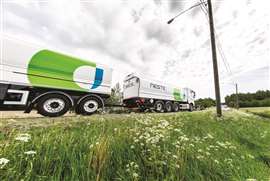 Like other OEMs, Kohler has approved all engines for HVO, including this diesel engine
Like other OEMs, Kohler has approved all engines for HVO, including this diesel engine
While HVO could seem a comparatively new alternative, as far back as in 2008 Neste Oils and SAE International released a white paper comparing the performance of pure HVO to a 30% HVO/70% diesel blend and EN 590 sulphur-free diesel fuel. The conclusion was that using default injection timings, the 100% HVO fuel delivered a 6% lower NOx output and 35% less smoke (read: ‘particulates’) compared to diesel alone.
But there are downsides, though. A report from contractor Balfour Beatty noted there were ‘serious issues’ with HVO that needed to be addressed, highlighting issues with traceability across sourcing, transportation and production methods, all of which could affect carbon-reduction claims.
While HVO production is increasing – total output is forecast to reach ten million tonnes across Europe by 2030 – this will likely still not be sufficient to wholly replace fossil diesel. Availability will be further compounded by bottlenecks in the distribution network.
Aftertreatment systems
In mid-2023, Eminox, a developer and manufacturer of emissions aftertreatment systems (EATS) released a white paper looking how the introduction of Euro 7/Stage 6 emissions regulations could impact various industries and their net-zero carbon goals.
To design EATS to meet these regulations, the company uses an ‘emissions reduction toolbox’ that includes a variety of mixing and dosing technologies, all of which fall under the umbrella of selective catalytic reduction (SCR).
Anthony Greatwood, global product manager at Eminox, said that compliance for Euro 7 on-highway and Stage 6 off-highway engines would be achieved by addressing two key areas: cold start emissions and particulate control.
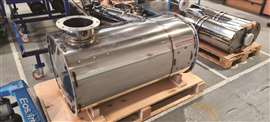 Stainless steel casing for one of the largest EATS systems from Eminox
Stainless steel casing for one of the largest EATS systems from Eminox
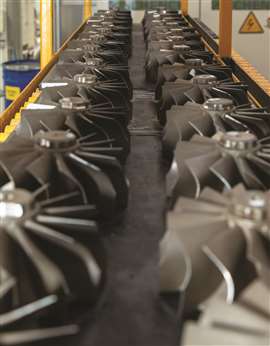 Turbo unit impeller wheels ready for final assembly at Cummins
Turbo unit impeller wheels ready for final assembly at Cummins
Looking at cold starts, there are two primary solutions now under investigation. These include a dual dose of diesel exhaust fluid being introduced to the exhaust stream, together with an electrically-heated catalyst to improve performance before engine temperatures increase.
However, there are problems to retrofitting these systems. Packaging space onboard the vehicle must be examined to understand if it’s possible to accommodate the related hardware together with weight considerations. In addition, if aftertreatment systems are added without calculating the impact on the engine, backpressure and increased load could ultimately make matters worse.
“The more aftertreatment and restriction you place on an engine, you are at odds with increasing efficiencies. You’re generating additional loads on the engine to create the power needed to control the emissions,” said Greatwood.
He explains that the best solution could be achieved by having the aftertreatment specialist involved from day one of ground-up engine development. This would support design of the most efficient system, reducing any compromises with regards to emissions reduction or power output.
This hints at the idea that an upgrade to an existing aftertreatment system could be both difficult to develop and expensive to deploy; issues that have to be balanced with the cost of replacing the equipment with new hardware.
Engine hardware
Together with low-carbon fuels and aftertreatment strategies, a further route to achieving emissions reductions in diesel engines is to improve the performance of related hardware and the software managing the engine control unit.
In basic terms, a turbocharger channels pressurised engine exhaust gas into the combustion chamber. This increase in air volume allows proportionally more fuel to be injected into the chamber, with a resulting increase in engine power. While early turbo units suffered from lag issues, modern turbo units deliver smooth power, improving boost delivery and reduced emissions.
Cummins is the only engine OEM that develops and manufactures its own turbo units. Marketed under the Holset brand, the turbos are designed for light-, medium- and heavy-duty applications, with many products featuring specific adaptations needed to improve performance.
The latest versions offer a wide flow range that allows for higher boost pressure at lower engine speeds, while the VG tech supports delivery of short-route exhaust gas recirculation to improve fuel efficiency and reduce NOx levels.
Cummins also produces wastegate turbo units. The wastegate controls the amount and timing of excess exhaust gas release using either pneumatically- or electronically-controlled configurations. Wastegate tech can prevent the turbo from over-speeding and reduce engine overboost. The feature is said to deliver a 3% increase in efficiency, while being compatible with various aftertreatment systems.
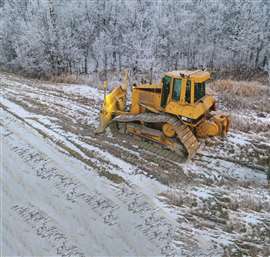 Biodiesel performs better than fossil in cold conditions
Biodiesel performs better than fossil in cold conditions
“The focus is on CO2 reductions across diesel, through to hydrogen fuel cell powertrains. We’ve been working on that for about two years and we’re looking to accelerate that technology,” said Brett Fathauer, executive director for Research and Engineering at Cummins Turbo Technology.
“We’re looking at air-handling tech, including compressors, turbines, efficiency improvements, together with e-machine upgrades and developments applicable to hybrid and fuel cell powertrains.”
Using computational fluid dynamics to understand the physical dynamics, next-gen turbo units are set to take advantage of ‘pulsed’ energy and redesigned shroud interfaces, respectively intended to optimise the interaction between air flow and turbines and efficiently direct flow into the combustion chamber to deliver optimised power levels.
Fuel injection
Elsewhere across the engine, the fuel injection system offers further potential for emissions reductions. The CRSN common-rail injection system from Bosch has been designed for use in construction machinery and industrial off-highway applications. Intended for engines with up to eight cylinders, a displacement of between four and 17 litres and a power output up to 1000 kW, the CRSN tech can deliver scalable fuel delivery pressures.
CRIN solenoid valves are key to the performance of the CRSN system. Operating at up to 2,500 bar, the high-pressure valves are able to atomise fuel into microscopic droplets. This promotes a cleaner burn, resulting in lower CO2 emissions, lower particulate counts and improved fuel consumption. Using information from the ECU, the CRSN system allows the injectors to deliver only enough fuel needed to match the operating load/situation.
Cold start solutions
It’s worth rounding out this coverage of technologies intended to reduce diesel engine emissions with details covering what is now regarded as a primary cause of engine pollution – cold starts. A whitepaper published by the School of Mechanical Engineering at Nantong University in China in 2023 looked at the root issues related to cold starts and strategies to try and reduce related emissions.
According to the material, incomplete combustion is unavoidable when the air temperature and engine temperature are both low. Essentially, atomisation of fuel is considerably more difficult in cold conditions, resulting in incomplete combustion. Emissions increases are also attributed to friction between engine components, with related wear contributing to increases across all pollutant types. Data quoted in the report noted that NOx emissions from heavy-duty diesel engines in cold start conditions could increase between 40% and 90%.
The paper reports that biodiesel can deliver significant CO2 reductions in cold-start emissions, although the high oxygen concentration in the fuel results in little change to the NOx and hydrocarbon counts. That said, production of these and other pollutants drops far more rapidly using biodiesel instead of fossil fuel.
Adding ethanol to biodiesel is reported to reduce NOx and hydrocarbon counts, but the low cetane value of the ethanol can see increases in carbon dioxide output.
The best route to reducing diesel engine emissions during cold starts is heating the assembly. In small- and medium-sized engines, glow plugs are used as an auxiliary device to improve cold start performance. Using these can reduce CO2, NOx and hydrocarbon output, with only a slight increase in particulates.
In summary, the report authors concluded that a combination of biodiesel, aftertreatment system, optimised fuel injection and intake heating would be required to achieve the peak emissions reductions of a diesel engine in low-temperature conditions.
While a solution is at hand, it would require all of these elements to be available/fitted to achieve the potential benefits.
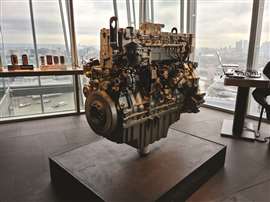
Futureproofed power solution
In September 2023, Perkins Engines held the UK press launch of its new 2600 Series engine. First shown at ConExpo earlier in the year, the 13-litre engine (also known as 2606) is designed to offer the power delivery of a 15- or 18-litre model, but with a smaller footprint and reduced emissions.
The engine produces between 340 and 515 kW while being about 20% lighter than a larger equivalent. In addition, the engine returns fuel economy figures as low as 185 g/kWh, while also supporting drop-in replacement fuels such as HVO and biodiesels to dramatically reduce the related carbon footprint.
While the engine is compliant with all current emissions regulations, it has been designed to accommodate configurations which will support adjustments to achieve compliance with all future standards in the US and EU.
STAY CONNECTED



Receive the information you need when you need it through our world-leading magazines, newsletters and daily briefings.
CONNECT WITH THE TEAM








